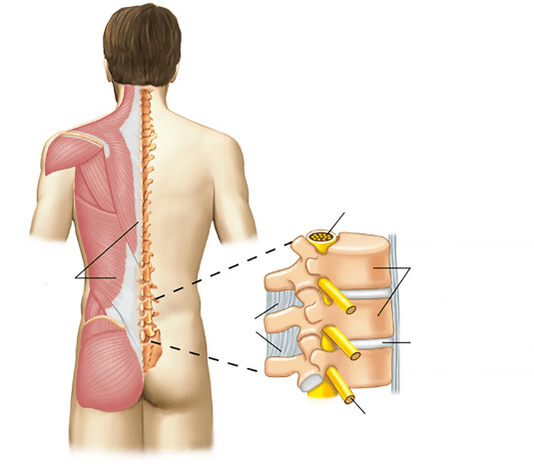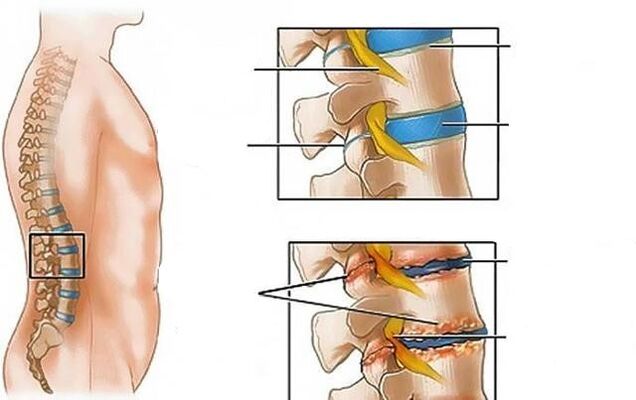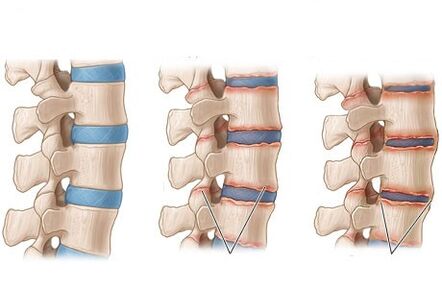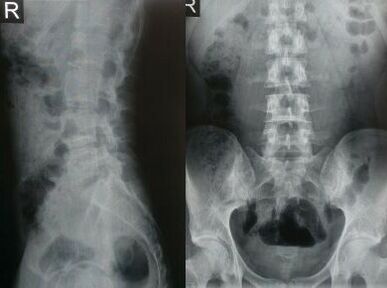Often, pain in the lumbar spine indicates the development of pathology, including the beginning of the inflammatory process. If treatment is not started on time, symptoms will increase and it will be more difficult to restore health. In this article, you will learn about the causes and treatment of lumbar spine pain.
If treatment is not started on time, symptoms will increase and it will be more difficult to restore health. In this article, you will learn about the causes and treatment of lumbar spine pain.
Characteristics of back pain
Depending on its nature, pain is classified into 3 types:
Chronicle.A person experiences discomfort while doing physical activities - when bending over, climbing stairs or turning the body. During a period of relapse (exacerbation), pain can increase and be given to various parts of the body.
Sharp.It occurs when the disc is displaced and is characterized by an acute painful sensation in the lower back. Limited mobility, a person cannot wake up from sleep, it is difficult for him to walk or bend over.
It hurts.It is accompanied by an unpleasant sensation that does not disappear in a long time. As a rule, excruciating pain indicates the development of diseases of the kidneys, genitourinary system. It can also be a symptom of osteochondrosis, spondyloarthrosis, spondyloarthritis.

In addition to pain and discomfort in the lumbar spine, patients may experience similar symptoms:
- muscle weakness;
- loss of urinary control and defecation;
- numbness in the legs;
- increased body temperature;
- shivering;
- groin / crotch pain;
- menstrual cycle violations.
If the discomfort does not go away in a long time and a person complains of several symptoms at once, it is important to contact a therapist immediately. Only a doctor can make an accurate diagnosis and prescribe treatment.
Causes of back pain
There are two main groups of diseases that cause pain syndrome to develop in the lumbar region:
Spinal problems:
Osteochondrosis.Degenerative-dystrophic disease in which the intervertebral disc loses its flexibility and ability to function normally. The disease can be resolved at an early stage, depending on timely treatment. Acute pain, aggravated by flexion, indicates progressive disease progression.

Spondylosis.Spinal disorders in which the intervertebral disc is depleted and worn out. The pathological causes are trauma and increased pressure on the spine. A person with spondylosis has difficulty turning the body. The disease is characterized by a slow course, so the results of treatment are often positive.
Scoliosis.Curvature of the spine, which can most often occur during adolescence due to rapid growth. The disease has 4 stages and can manifest itself as pain in the lower back.
Lumbago.A sudden shooting pain in the lumbar spine, if a person freezes in an uncomfortable state. Mobility with lumbago is also limited.
Osteoporosis.Serious pathology in which the spine becomes porous, losing its density and elasticity. Lower back pain may occur during weight lifting, changing body position and other loads.
Systemic joint disease, in which, a person experiences stiffness, pain and tension in the back muscles in the lumbar region. This unpleasant sensation can increase at night and cause frequent awakening. Pain is overcome with movement and exercise.

Myofascial syndrome.A relatively common disease that arises due to prolonged uncomfortable posture or after physical exercise. Its special feature is the presence of a trigger point (pain) in the lower back or in the buttocks. While pressing on them, a sharp pain occurs.
Diseases of internal organs:
Attacks of appendicitis.Depending on the functional characteristics of the human body, pain can appear on the right side and be given to the lower back.
Inflammation of the kidneys.The main symptoms in case of impaired renal function are pain and unpleasant soreness in the lumbar region. It can also be accompanied by the appearance of edema and an increase in body temperature.
PancreatitisWith the progression of the disease, a person may experience nausea, vomiting, and abdominal pain. If the lower back pain is caused precisely by pancreatitis, then the pain will not increase when pounding on the spine.
Cholecystitis.The pain is localized in the right hypochondrium, while it radiates to the lower back. Lumbago and discomfort in the lower back indicate the involvement of spinal nerve fibers in the pathological process.
EndometriosisGynecological disease, in which the inner cells of the lining of the uterine wall grow beyond its limits. The woman experienced pain in the lumbar region.
Obesity.Excess weight puts unnecessary pressure on the lower back and intervertebral discs. As a result, they change shape and collapse. One feels uncomfortable when walking long distances or climbing stairs.
Oncology.Back pain can occur if there is a benign or malignant tumor. This "absorbs" a lot of calcium, there is a lack of bone structure, they become thinner.
Physiology of back pain causes
Hypothermia. Prolonged exposure to fresh air in cold weather can cause numbness in the lower back. At the same time, discomfort increases when bending, moving and twisting. Sometimes he can give on legs or ass.
Critical day. During the menstrual cycle, about 50% of women experience an unpleasant and exciting sensation in the lower abdomen, which extends to the lumbar region. As a rule, the discomfort disappears after the end of the cycle.
Excessive load. Excessive weight gain and excessive pressure on the lumbar region cause a painful sensation.
Peak. During menopause, the levels of estrogen, the hormone that regulates the recovery process, decrease in a woman’s body. Bone tissue loses the ability to fully recover. They become fragile.
Uncomfortable shoes. Wearing high heels and tight shoes will compress the blood vessels in your feet. As a result, lower back pain is painful.
Lack of physical activity. An inactive lifestyle and lack of exercise contribute to chronic back pain. Muscle atrophy and loss of natural elasticity.
Diagnostics
First, the doctor interviews and examines the patient. He set up the general chemical analysis section (blood and urine donation). To get an overview and exclude serious pathological changes, it is recommended to undergo:
CT.Modern diagnostic methods by which you can detect the development of pathology at an early stage. He clearly describes all the structures of the bones.
MRI.Indicates the condition of soft tissues and cartilage. Also, with the help of MRI, tumors, intervertebral hernias and changes in blood vessels are diagnosed.
X-ray.Provides information on changes in the structure of the bones of the spine, indicates the presence of bruises, microcracks and helps detect pathology of the spine.
Ultrasound.Allows you to determine the state of internal organs, as well as detect inflammatory processes.

Based on the data obtained, the doctor makes a diagnosis and prescribes treatment. If necessary, she offers to be examined by other specialists: gynecologist, endocrinologist, gastroenterologist.
How to cure back pain
The method of treatment depends on the disease and is prescribed individually. As a rule, complex therapy is most effective. They usually recommend:
- avoid lifting weights;
- taking B group vitamins and calcium;
- use a support bandage;
- swim, move more or follow medical gymnastics;
- taking corticosteroids to relieve severe inflammation (as directed by a doctor);
- muscle relaxation to relieve cramps.
Depending on the cause of the disease, the doctor may prescribe a sleep break or, conversely, an increase in physical activity. For example, if a nerve is pinched, passive rest is recommended. For some muscle cramps, massage and moderate exercise. Treatment methods include:
Physiotherapy.Includes a number of methods of physical impact on the affected area. With its help, microcirculation is improved, edema and cramps disappear, and also can achieve anti-inflammatory effect.
Manual therapy.An alternative medicine used to treat the musculoskeletal system. Specialists find places where nerves are pinched and help spasmodic muscles relax. It also soothes places that are, on the other hand, very relaxing.
Acupuncture.Helps relieve pain through the use of special needles. They are injected into active points on the body and spine. The muscles feel relaxed and the lower back becomes healthier.
When conservative therapy fails, it is necessary to consult a neurosurgeon. Often, surgery is prescribed for intervertebral hernias, which cause a violation of the spinal roots and the occurrence of radicular pain.
What to do for severe back pain
For intolerable acute lower back pain, patients are given restrictions. A procedure in which a doctor injects a painkiller into the area where the pain occurs or where nerve fibers pass. This radical method relieves pain temporarily. In addition, specialists may prescribe antibiotics, immunomodulators and chondroprotectors.
With severe back pain, do not self -medicate or persist. This can lead to potentially fatal consequences, including disability or death.
Prevention and prognosis
Try to keep a balance between work and play. An inactive lifestyle and lack of physical activity are the main causes of back pain.
If you work at a computer or drive all day, try to find time to exercise or take a walk. No need to spend two hours on the board. You can choose the appropriate exercises from yoga, fitness or Pilates and do them at home.
Carry a load in your backpack. This will help distribute the load on your back evenly and not tear it. When lifting something heavy, bend the legs, not the buttocks. If you need to reach from above, use a ladder or chair.
Get a sequence. Visit a massage therapist twice a year and undergo a massage course of at least 10 sessions. This will help relieve muscle cramps and improve overall health.
Get orthopedic mattresses and pillows. In a dream, a person spends his whole life. Make sure that during this time you feel comfortable and can relax completely. Buy the product in an orthopedic salon after consulting with the seller.
In order not to endanger yourself, be wary of traditional medical methods and self-treatment. If you need expert help, you can contact our clinic. To make an appointment, leave a request or call.























